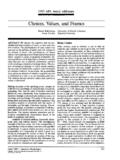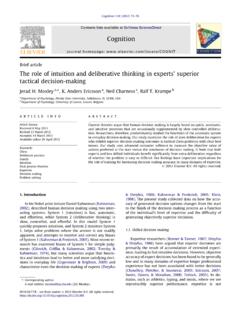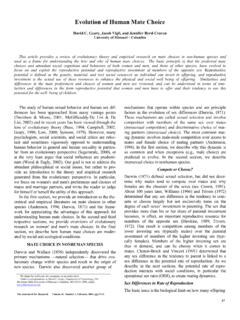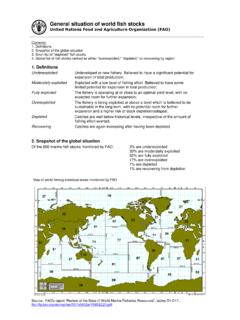Transcription of GENETIC AND ENVIRONMENTAL INFLUENCES ON HUMAN …
1 Annu. Rev. Neurosci. 1998. 21:1 24 Copyrightc 1998 by Annual Reviews Inc. All rights reservedGENETIC AND ENVIRONMENTALINFLUENCES ON HUMANBEHAVIORAL DIFFERENCESMatt McGue and Thomas J. Bouchard, JrDepartment of Psychology and Institute of HUMAN Genetics, 75 East River Road,University of Minnesota, Minneapolis, Minnesota 55455;e-mail: WORDS: heritability, gene-environment interaction and correlation, nonshared environ-ment, psychiatric geneticsABSTRACTH uman behavioral GENETIC research aimed at characterizing the existence andnature of GENETIC and ENVIRONMENTAL INFLUENCES on individual differences in cog-nitive ability, personality and interests, and psychopathology is reviewed.
2 Twinand adoption studies indicate that most behavioral characteristics are , efforts to identify the genes influencing behavior have produceda limited number of confirmed linkages or associations. Behavioral GENETIC re-search also documents the importance of ENVIRONMENTAL factors, but contrary tothe expectations of many behavioral scientists, the relevant ENVIRONMENTAL factorsappear to be those that are not shared by reared together relatives. The observationof genotype-environment correlational processes and the hypothesized existenceof genotype-environment interaction effects serve to distinguish behavioral traitsfrom the medical and physiological phenotypes studied by HUMAN geneticists.
3 Be-havioral GENETIC research supports the heritability, not the GENETIC determination,of ,andattimesmostcontentious,debatesinWest ernintellectualhistory concerns the relative influence of GENETIC and ENVIRONMENTAL factorson HUMAN behavioral differences, the so-called nature-nurture debate (Degler1991). Remarkably, the past generation of behavioral GENETIC research has led10147-006X/98/0301-0001$ & BOUCHARD many to conclude that it may now be time to retire this debate in favor of aperspective that more strongly emphasizes the joint influence of genes and theenvironment.
4 Nonetheless, the controversy surrounding the recent publicationofTheBellCurve(Herrnstein & Murray 1994) shows that the proposition thatgenetic factors influence fundamental aspects of our HUMAN nature continuesto inflame behavioral genetics seeks to identify and characterize both the geneticand the ENVIRONMENTAL sources of individual differences (phenotypic variance)in HUMAN behavior. As this topic has not been previously reviewed in this se-ries, we have taken a broader perspective than might be customary, electing toconsider the past 25 years of behavioral GENETIC research, albeit with a decidedemphasis on research published in the past 5 years.
5 The reader may also want toconsult the recent general review of this area by Rose (1995), as well as specificreviews of behavioral GENETIC research on crime and violence (Bock & Goode1996), behavioral medicine (Turner et al 1995), psychiatric genetics (Blum &Noble 1997, McGuffin et al 1994), intelligence (Sternberg & Grigorenko 1997),and personality (Loehlin 1992). Our review is organized around three broad as-pects of behavioral GENETIC research (a) the nature of GENETIC influence, (b)the nature of ENVIRONMENTAL influence, and (c) models for the joint influenceof genes and the environment and is focused on three broad domains of psy-chological functioning (a) cognitive ability, (b) personality and interests, and(c) psychopathology.
6 We do not review research on mental retardation andneurogenetic disorders such as Alzheimer s disease and CONSIDERATIONSIn standard biometrical formulations, the phenotypic variance is decomposedinto GENETIC and ENVIRONMENTAL components. The GENETIC component is furtherdecomposed into additive and nonadditive components, the latter reflectinginteractive effects within (dominance) and among (epistasis) loci. The envi-ronmental component is decomposed into a shared ENVIRONMENTAL component,representing the effects of characteristics such as family income, parental strate-gies on child-rearing, and level of intellectual stimulation within the home thatare shared by reared together relatives and are thus a potential source of theirbehavioral similarity.
7 And a nonshared ENVIRONMENTAL component, representingthe effects of characteristics such as accidents, peer affiliations, and differentialparental treatment that are not shared by reared together relatives and are thus asource of their behavioral dissimilarity. Three general strategies have been usedto resolve the separate influence of GENETIC and shared ENVIRONMENTAL factorson the familial resemblance that characterizes the vast majority of behavioraltraits: twin studies, adoption studies, and gene identification BEHAVIORAL GENETICS3 The classical twin study involves the comparison of monozygotic and dizy-gotic twins reared together (MZTs and DZTs).
8 If GENETIC factors influence thetrait in question, MZTs, who share 100% of their GENETIC material, should bemore similar than DZTs, who, like ordinary siblings, share on average only 50%of their GENETIC material. In a classical twin study, the proportion of phenotypicvariance associated with additive GENETIC factors ( the narrow heritability)is estimated by doubling the difference in correlation between the MZTs andDZTs, the contribution of shared ENVIRONMENTAL factors is estimated by subtract-ing the heritability estimate from the MZT correlation, and the contribution ofnonshared ENVIRONMENTAL factors and measurement error is estimated by sub-tracting the MZT correlation from These estimates, like any statistics, canchange over time and vary across culture.
9 Nonetheless, they have proven tobe useful indices for characterizing the sources of individual differences inpsychological traits ( Neisser et al 1996). Powerful methods for analyzingtwin data and estimating ENVIRONMENTAL and GENETIC components of varianceare now available (Neale & Cardon 1992). Owing to the availability of severallarge population-based twin registries in Western Europe, the United States,and Australia, the classical twin study is a popular behavioral GENETIC assumptions that underlie the classical twin study have drawn substantialempirical attention that has generally supported the basic validity of this method(Plomin et al 1990b).
10 An adoption study involves determining the degree to which adopted individ-uals resemble both their biological relatives, an indication of GENETIC INFLUENCES ,as well as their adoptive relatives, an indication of shared ENVIRONMENTAL influ-ences. Although there are some notable US adoption studies, most adoptionresearch has been undertaken in Scandinavian countries, where the availabilityof national registries has allowed researchers to ascertain relatively large andrepresentative cohorts of adopted individuals as well as both their adoptive andbiological relatives.















